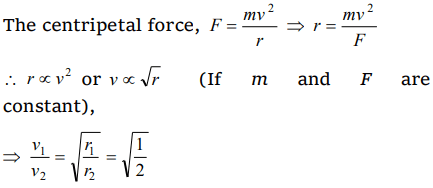1. A person with his hands in his pockets is skatingon ice at the velocity of 10 m/s and describes a circle of radius 50 m. What is his inclination with vertical
a) \[\tan^{-1}\left(\frac{1}{10}\right)\]
b) \[\tan^{-1}\left(\frac{3}{5}\right)\]
c) \[\tan^{-1}\left(1\right)\]
d) \[\tan^{-1}\left(\frac{1}{5}\right)\]
Explanation:

2. If the radius of curvature of the path of two particles of same masses are in the ratio 1 : 2, then in order to have constant centripetal force,
their velocity, should be in the ratio of
a) 1 : 4
b) 4 : 1
c) \[\sqrt{2}:1\]
d) \[1:\sqrt{2}\]
Explanation:

3. An object is moving in a circle of radius 100 m
with a constant speed of 31.4 m/s. What is its
average speed for one complete revolution
a) Zero
b) 31.4 m/s
c) 3.14 m/s
d) \[\sqrt{2}\times 4. 31m/s\]
Explanation: As the speed is constant throughout the circular motion therefore its average speed is equal to instantaneous speed
4. A body of mass 1 kg tied to one end of string is revolved in a horizontal circle of radius 0.1 m with a speed of 3 revolution/sec, assuming the
effect of gravity is negligible, then linear velocity, acceleration and tension in the string will be?
a) \[1.88 m \diagup s,35.5 m \diagup s^{2} , 35.5 N\]
b) \[2.88 m \diagup s,45.5 m \diagup s^{2} , 45.5 N\]
c) \[3.88 m \diagup s,55.5 m \diagup s^{2} , 55.5 N\]
d) None of these
Explanation:

Tension in string,
T = \[m \omega^{2} r = 1\times(6\pi)^{2}\times0.1 = 35.5 N\]
5. The acceleration of a train travelling with speed of 400 m/s as it goes round a curve of radius 160 m, is
a) \[1 km\diagup s^{2}\]
b) \[100 m\diagup s^{2}\]
c) \[10 m\diagup s^{2}\]
d) \[1 m\diagup s^{2}\]
Explanation:

6. A car of mass 800 kg moves on a circular track of radius 40 m. If the coefficient of friction is 0.5, then maximum velocity with which the car can
move is
a) 7 m/s
b) 14 m/s
c) 8 m/s
d) 12 m/s
Explanation:

7. A 500 kg crane takes a turn of radius 50 m with velocity of 36 km/hr. The centripetal force is
a) 1200 N
b) 1000 N
c) 750 N
d) 250 N
Explanation:

8. Two bodies of equal masses revolve in circular orbits of radii \[R_{1}\] and \[R_{2}\] with the same period. Their centripetal forces are in the ratio
a) \[\left(\frac{R_{2}}{R_{1}}\right)^{2}\]
b) \[\frac{R_{1}}{R_{2}}\]
c) \[\left(\frac{R_{1}}{R_{2}}\right)^{2}\]
d) \[\sqrt{R_{1}R_{2}}\]
Explanation:

9. In case of uniform circular motion which of the
following physical quantity do not remain
constant
a) Speed
b) Momentum
c) Kinetic energy
d) Mass
Explanation: It is a vector quantity.
10. What happens to the centripetal acceleration of a revolving body if you double the orbital speed v and half the angular velocity \[\omega\]
a) The centripetal acceleration remains unchanged
b) The centripetal acceleration is halved
c) The centripetal acceleration is doubled
d) The centripetal acceleration is quadrupled
Explanation:
